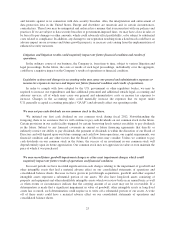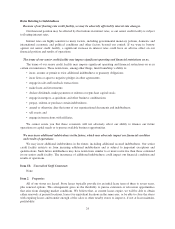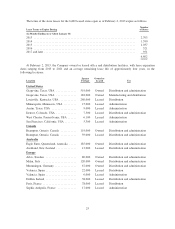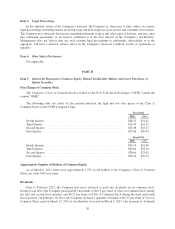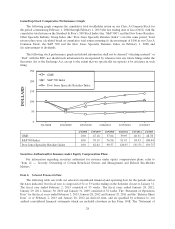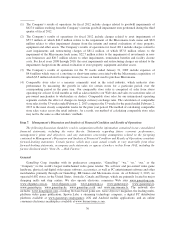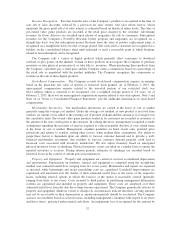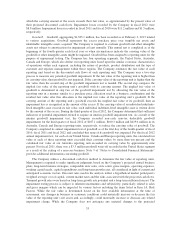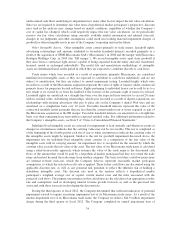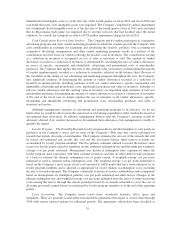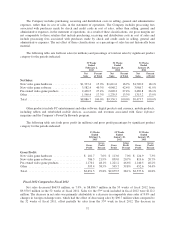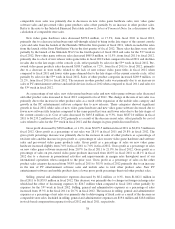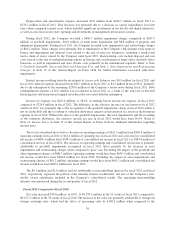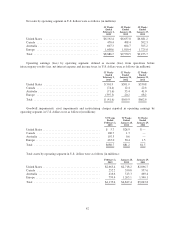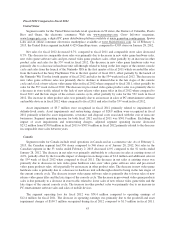GameStop 2012 Annual Report Download - page 48
Download and view the complete annual report
Please find page 48 of the 2012 GameStop annual report below. You can navigate through the pages in the report by either clicking on the pages listed below, or by using the keyword search tool below to find specific information within the annual report.which the carrying amount of the assets exceeds their fair value, as approximated by the present value of
their projected discounted cash flows. Impairment losses recorded by the Company in fiscal 2012 were
$8.8 million. Impairment losses recorded in fiscal 2011 and fiscal 2010 were $11.2 million and $1.5 million,
respectively.
Goodwill. Goodwill, aggregating $1,383.1 million, has been recorded as of February 2, 2013 related
to various acquisitions. Goodwill represents the excess purchase price over tangible net assets and
identifiable intangible assets acquired. The Company is required to evaluate goodwill and other intangible
assets not subject to amortization for impairment at least annually. This annual test is completed as of the
beginning of the fourth quarter each fiscal year or when circumstances indicate the carrying value of the
goodwill or other intangible assets might be impaired. Goodwill has been assigned to reporting units for the
purpose of impairment testing. The Company has four operating segments, the United States, Australia,
Canada and Europe, which also define our reporting units based upon the similar economic characteristics
of operations within each segment, including the nature of products, product distribution and the type of
customer and separate management within those regions. The Company estimates the fair value of each
reporting unit based on the discounted cash flows of each reporting unit. The Company uses a two-step
process to measure any potential goodwill impairment. If the fair value of the reporting unit is higher than
its carrying value, then goodwill is not impaired. If the carrying value of the reporting unit is higher than the
fair value, then the second step of the goodwill impairment test is needed. The second step compares the
implied fair value of the reporting unit’s goodwill with its carrying amount. The implied fair value of
goodwill is determined in step two of the goodwill impairment test by allocating the fair value of the
reporting unit in a manner similar to a purchase price allocation used in a business combination and the
residual fair value after this allocation is the implied fair value of the reporting unit’s goodwill. If the
carrying amount of the reporting unit’s goodwill exceeds the implied fair value of its goodwill, then an
impairment loss is recognized in the amount of the excess. If the carrying value of an individual indefinite-
lived intangible asset exceeds its fair value, such individual indefinite-lived intangible asset is written down
by the amount of the excess. During the third quarter of fiscal 2012, the Company determined that sufficient
indicators of potential impairment existed to require an interim goodwill impairment test. As a result of the
interim goodwill impairment test, the Company recorded non-cash, non-tax deductible goodwill
impairments for the third quarter of fiscal 2012 of $107.1 million, $100.3 million and $419.6 million in its
Australia, Canada and Europe reporting units, respectively, to reduce the carrying value of goodwill. The
Company completed its annual impairment test of goodwill as of the first day of the fourth quarter of fiscal
2010, fiscal 2011 and fiscal 2012 and concluded that none of its goodwill was impaired. For the fiscal 2012
annual impairment test, for each of our United States, Canada and Europe reporting units, the calculated fair
value of each of these reporting units exceeded their carrying values by more than ten percent and the
calculated fair value of our Australia reporting unit exceeded its carrying value by approximately nine
percent. For fiscal 2011, there was a $3.3 million goodwill write-off recorded in the United States segment
as a result of the exiting of a non-core business. Note 9 of “Notes to Consolidated Financial Statements”
provides additional information concerning goodwill.
The Company utilizes a discounted cash flow method to determine the fair value of reporting units.
Management is required to make significant judgments based on the Company’s projected annual business
plans, long-term business strategies, comparable store sales, store count, gross margins, operating expenses,
working capital needs, capital expenditures and long-term growth rates, all considered in light of current and
anticipated economic factors. Discount rates used in the analysis reflect a hypothetical market participant’s
weighted average cost of capital, current market rates and the risks associated with the projected cash flows.
Terminal growth rates were based on long-term growth rate potential and a long-term inflation forecast. The
impairment testing process is subject to inherent uncertainties and subjectivity, particularly related to sales
and gross margins which can be impacted by various factors including the items listed in Item 1A. Risk
Factors. While the fair value is determined based on the best available information at the time of
assessment, any changes in business or economic conditions could materially increase or decrease the fair
value of the reporting unit’s net assets and, accordingly, could materially increase or decrease any related
impairment charge. While the Company does not anticipate any material changes to the projected
33


